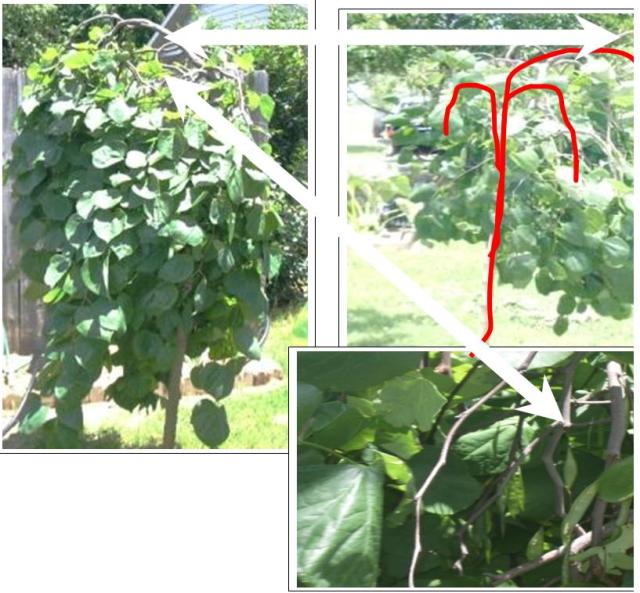Question
 3-shot of "Weeping Red
3-shot of "Weeping Red
I rescued a couple of "dead" trees from the dumpster of my favorite big box store, planted them PROPERLY (2' x 2' x 2' hole w/ 5 or 6 4" holes bored another 24" then 6" of gravel for drainage, 50/50 mixture of friable soil and what came out of the hole around the ball nearly to the diameter of the hole and original dirt mixed with a little sand to fill hole, w/ irrigation at the root ball) and lo and behold the "dead" trees are doing beautifully! But I have no idea what they are. The teenager at the store said they were "weeping redbud". They produce prolific redbud-looking flowers early in the spring, followed by heart-shaped leaves 3" to 4" wide on branches that droop--some to the ground--like those on a weeping willow.
I have made a valiant attempt to get three pictures into one image. The red lines roughly (!) indicate the shape of the branches concealed by the leaves; the white double-arrows indicate the approximate same spot in all three. If this shoot-hard-and-hope montage didn't come through I'll be less ambitious and just send one.
I'd like to know what they are, and whether they should be (loosely) staked near the top. It appears that the weight of the branches and leaves are causing the main trunk to begin bending, and I'm VERY concerned that one of the horrific "toad-stranglers" we get in the fall might cause the main trunk to crack or snap.
I await your knowledge, and if I can return the favor regarding "Decks" I'd be honored.
Mac
AnswerThe Lavender Twist Weeping Redbud, 'Cercis canadensis "Covey", also known as Twisted Lavender Redbud, is a new variety of Redbud that is sure to attract the eye. The reddish-purple bud opens to a rosy lavender-pink flower in early spring. The umbrella shaped tree accentuates the weeping, twisted branches tipping towards the ground. They flower in early spring and bloom for 2 to 3 weeks. The shape of the fruit looks like a pea pod. The pods are 2-3?and are brown. The seed pods develop in October and usually stay on throughout the winter and adding winter interest. Leaves are heart shaped, when emerging in the spring are reddish-purple changing to a dark lustrous green in the summer and then to a yellow fall color. This tree is a great specimen plant and perfect for a small protected area in the landscape.
The genetics of the tree makes it bend in the umbrella shape. No need to stake the tree. This is normal and a great looking tree.
Email me at
[email protected] and I will take a look at the system and give you my opinion.






